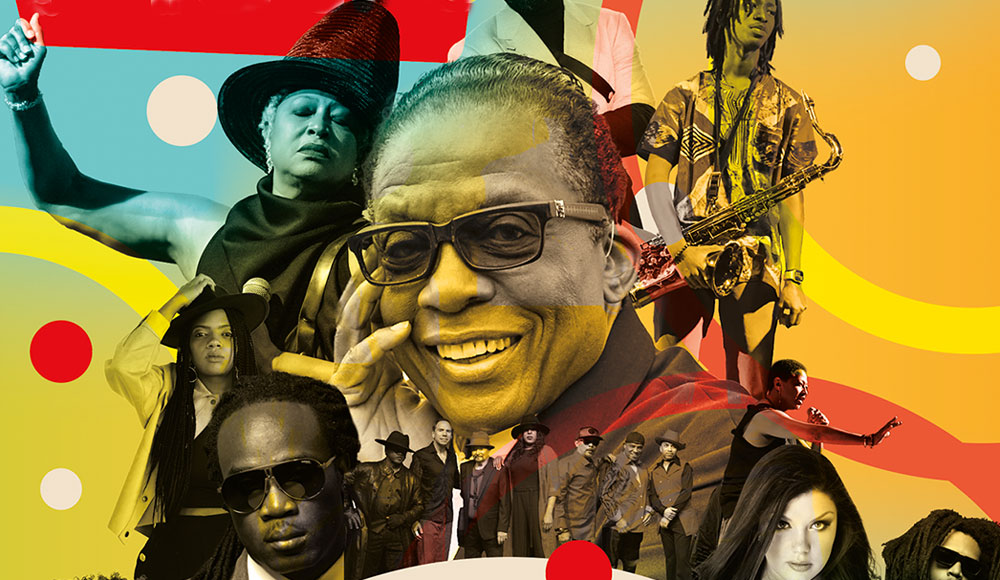Three days, multiple stages, with shows from morning to night, showcasing all manner of musical styles represented—this is the banquet of sound served up every year by San Jose Jazz Summer Fest. And while jazz is the central musical theme, all manner of musical styles are represented in this annual convocation at which regional artists play on the same bill as national and international artists.
One big draw at the three-day festival is sure to be post-bop/jazz fusion great Herbie Hancock, who’ll work the keyboard on Saturday. More than 80 other shows can be heard across seven stages (nine on Saturday and Sunday).
Friday evening’s headliners include Black Joe Lewis & the Honeybears, Las Cafeteras, Incognito, Kiefer, the David Benoit Quartet, Telemakus and the Family Stone (See below for an interview with band co-founder Jerry Martini and vocalist Phunne Stone.)
Saturday’s schedule kicks off at noon and runs past midnight, with a lineup that includes headliners Lucía Gutiérrez Rebolloso, Jorge Luis Pacheco Trio, Cory Henry & the Funk Apostles, Spanish Harlem Orchestra and the Sean Mason Quartet. (An interview with Mason is below.)
The third and final day of this year’s festival begins at noon and features Mrs. Lisa Fischer & Grand Baton, Jane Monheit, Delfeayo Marsalis & the Uptown Jazz Orchestra, Maze (with guest appearance by Frankie Beverly) and Dominique Fils-Aimé. Sunday’s lineup also features young Oakland jazz saxophonist Ayo Brame. (See interview with Brame below.)
Summer Fest takes place in downtown San Jose, on both indoor and outdoor stages within easy walking distance. Various ticket levels are offered for this year’s event. A three-day All Stages pass is $146.60; a three-day pass with access to all outdoor stages is $115.60. Single-day tickets, VIP, priority access and children’s tickets are also available; visit summerfest.sanjosejazz.org for details and purchasing.
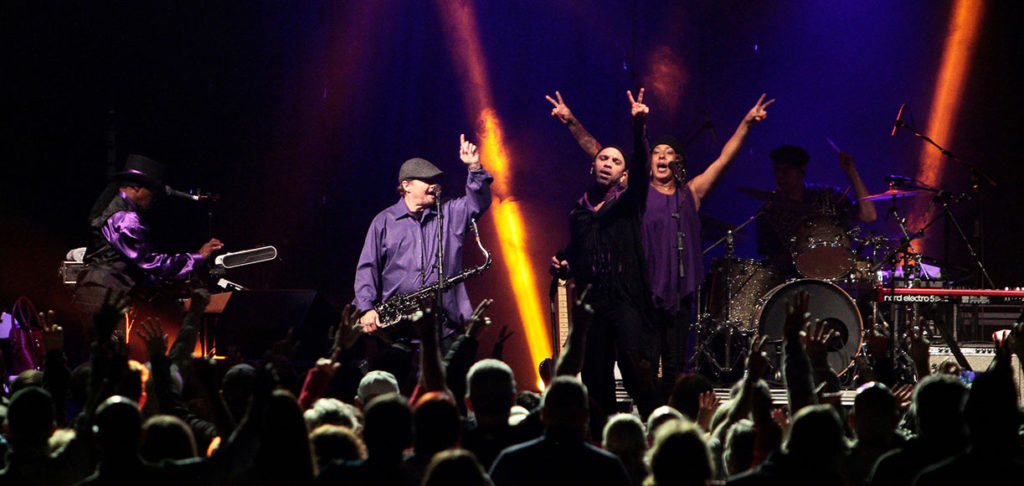
All in the Family: The Family Stone
Roaring out of Vallejo in the mid ’60s with a look and sound that set them apart from their contemporaries, Sly and the Family Stone quickly climbed the charts. The group’s star burned brightly and quickly; the classic lineup folded by the middle of the next decade. Today a founding member and one of Sly’s talented progeny are keeping the sound and spirit alive leading the Family Stone.
Saxophonist Jerry Martini’s friendship and musical association with Sly Stone goes back much earlier than the formation of Sly and the Family Stone, all the way back to the very early 1960s. At the time, Stone—then still known as Sylvester Stewart—was singing and playing in a teenage vocal group called the Viscaynes. “I played with Joe Piazza and the Continentals,” Martini says. “We used to back them up.” That’s Martini and his band mates backing Sly and his fellow Viscaynes on the regional hit “Yellow Moon.”
A few years later when Martini was playing sax in George and Teddy and the Condors, he was enlisted by Stewart—by then a burgeoning songwriter and producer—to play on a Bobby Freeman session. That 1964 recording, “C’mon and Swim” rose to the No. 5 spot on Billboard’s national singles chart. “That was Sly’s first Gold record,” Martini says.
Stewart soon changed his name to Sly Stone, and put together a group called Sly and the Stoners. “That’s what they were,” Martini laughs. Without a hint of irony, he notes that members of that short-lived group “were always late for rehearsals, smoking on stage, not showing up for gigs.” At the time, apparently, Stone had little patience for such behavior, so he broke up the group and became a DJ.
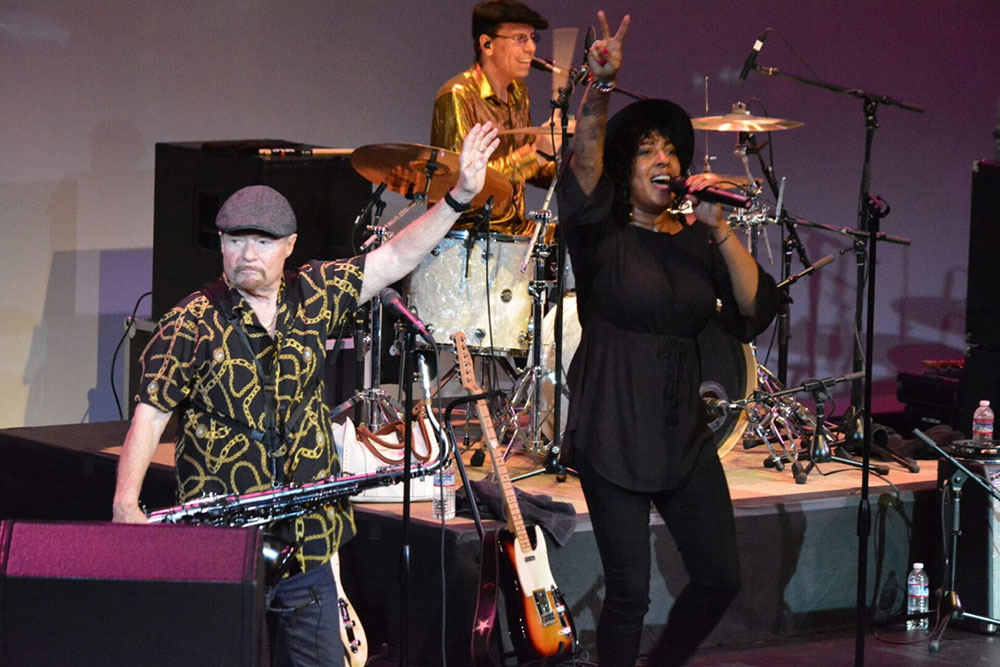
Martini kept in touch with Sly, and continued to encourage him to put a proper, professional group together. “I’ll send for you when I’m ready,” Stone told Martini. By 1966, Stone formed Sly and the Family Stone.
The group featured Stoners trumpeter Cynthia Robinson along with Martini and two of his band mates from Freddie and the Stone Souls: Sly’s brother Freddie (sister Rose joined later) and drummer Greg Errico. Adding guitarist Larry Graham, the groundbreaking group was complete.
Interracial and featuring both sexes, Sly and the Family Stone were unusual for the time. But it was the music that truly set the band apart. Combining rock, soul, R&B and funk, it was like nothing else happening on the national music scene.
Through the group’s heyday (roughly 1967 to 1974), Sly and the Family Stone landed 13 of its 14 singles on the R&B or pop Top 40 singles charts; often both. And three of those—“Everyday People,” “Thank You (Falettinme Be Mice Elf Agin)” and “Family Affair”—soared all the way to the #1 spot on both charts. But Sly’s substance abuse and erratic behavior were only the most visible problems within the band, and by the early ’70s the group’s lineup frayed. By early 1975 the group was over.
Yet the popularity of the Family Stone’s music has endured, and so some years after the original group ended, Martini relaunched the band without Sly. Today the Family Stone features Martini plus Sly’s daughter Phunne Stone on vocals along with musicians Frank Klepacki, Jimi McKinney, Blaise Sison, Swang Stewart and Nate Wingfield. The Family Stone conjures the vibe of the original group, with a rock-solid set list and warm, upbeat vibe.
Growing up as the daughter of Cynthia Robinson and Sly, Phunne wasn’t completely aware of her family’s importance in the world of music. “I knew something was up,” she says, “but it wasn’t matching with our circumstances.” Her childhood was filled with encounters with famous and acclaimed musical figures. “But I didn’t even know who I was around,” she says. Yet as she grew up, she began to notice. “I started thinking, ‘This is not the same as at my friends’ houses.’”
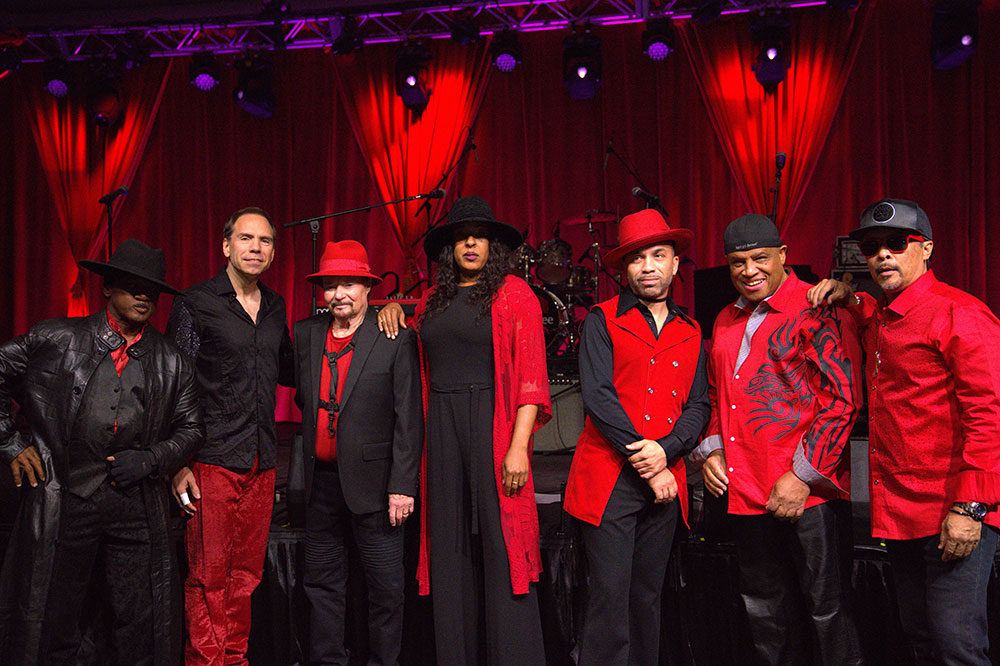
Phunne joined the Family Stone about a decade ago. “My favorite part of being in the group is being able to see the audience’s faces when their [favorite] song comes on,” she says. “You can see that click—that memory—and then they’re just in the moment, really enjoying it.”
Today at age 81, Martini says that the Family Stone is about more than nostalgia. “I believe that Sly is one of the greatest songwriters,” he enthuses. “So we’re going to keep the legacy going. And when Phunne takes over, she may change it. Maybe Papa will even write a song for her, bring in some new stuff.”
In fact Phunne does remain in regular contact with the famously mercurial and elusive Sly Stone. “He’s older now, and he’s lived a pretty fast life,” she says with a chuckle. “But he’s still bouncy, and he talks more shit than the law allows!”
The Family Stone’s set at this year’s San Jose Jazz Festival happens Friday, Aug. 9 at 7:30 p.m. on the Jay Paul Company Main Stage.
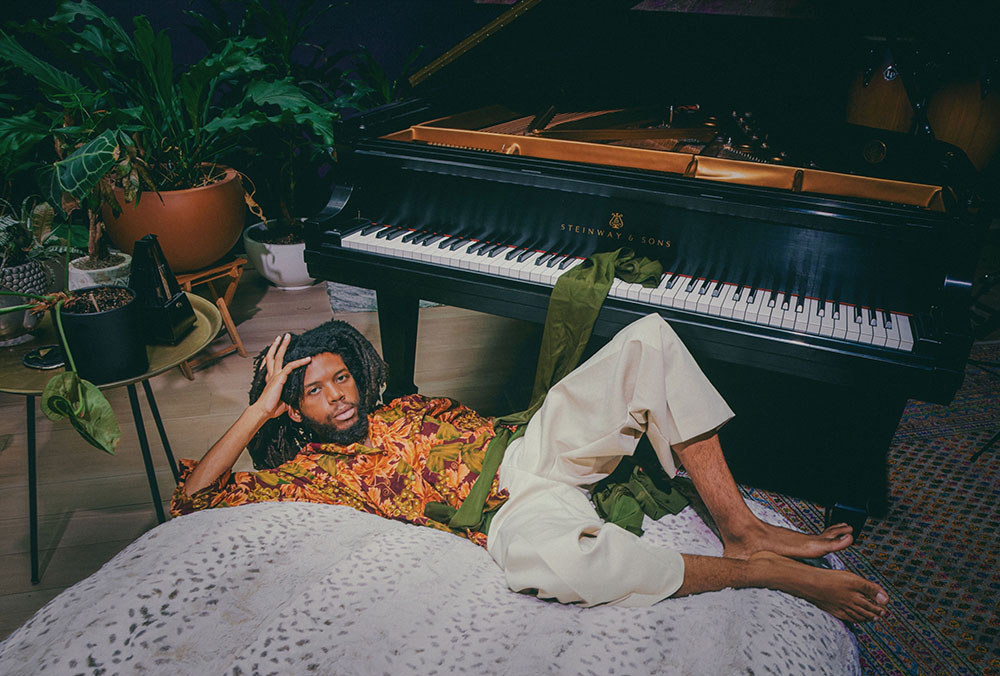
Eight Arms to Hug You: Sean Mason
A protégé of jazz/classical luminary Branford Marsalis, Sean Mason first came to wide attention with his 2023 release, The Southern Suite. But the Juilliard-trained pianist, composer and band leader had already established himself as a vital part of the jazz community. His music has a distinctively melodic character; that quality arose naturally thanks to Mason’s formative years.
“I love melody,” he explains. “I grew up singing in church, and I also grew up with popular music.” He notes that in his younger years, his friends and classmates didn’t listen to jazz. “Who wanted to listen to jazz?” he asks rhetorically, and with a laugh. “I didn’t want to go to school and be like, ‘Hey man, you heard these Coltrane records?’ Nobody cared about those kinds of things!”
But Mason did care. “I’m thankful to have parents who introduced me to that music,” he says. At home he’d hear the music of Duke Ellington and Ray Charles; for Mason, the latter represented a bridge between jazz and popular music. And unlike his friends, he willingly, enthusiastically listened to jazz. “I remember being 13 or 14 and having my headphones on at school,” he says. He was spinning some Miles Davis. “The trumpet was so loud that they could hear it through the ’phones. And my friends were picking on me.” Mason says that it was “a journey” to develop the confidence to admit liking jazz.
Mason says that as he listened and studied the form, it was the music’s melodic qualities that drew him in. “So when I had the opportunity to write and record my music, I wanted to make sure to honor those values,” he says.
Mason encountered one of his inspirations when he was an 18-year-old student at UNC Greensboro. “I met Branford Marsalis when he was an artist-in-residence at North Carolina Central.” Once a semester, Marsalis gave a lesson to students at other colleges. When he visited UNCG, he met Mason. “He really took a liking to my playing,” Mason says. Not long after, Marsalis took the young pianist on the road with him.

Marsalis enlisted Mason to play piano on his soundtrack for the Academy Award-winning 2020 film Ma Rainey’s Black Bottom. Set in 1927 Chicago, the film features both period music from Rainey and additional pieces composed by Marsalis. Mason says that his mission for the pandemic-era sessions in New Orleans was a specific and challenging one. “Musically, I had to pretend that 1930 and after didn’t happen,” he explains.
That experience informed Mason’s solo debut. Featuring all original material, The Southern Suite has a character that once again displays Mason’s emphasis upon melody. He says that the album’s eight pieces “all come from the same melodic and harmonic family; they’re just different branches of that tree.” He believes that sense binds the songs together as a cohesive whole. “They feel like eight different arms, all hugging you.”
He believes that rather than sporting a Southern “sound,” the album as a whole instead has a Southern sensibility. “I think the Southern tradition instilled some traditional values in me as a person,” he says, “values that then I can portray in my music.”
Central among those values, Mason believes, is a respect for one’s elders. “There’s a lot to learn from them,” he says. “And the South has taught me that history repeats itself.” He says that studying music of the past and honoring his roots has brought a certain character to his original work. With The Southern Suite, he aimed to express his own musical voice while remaining rooted in tradition. “I grew up with that sound, that soul, that spirit,” he says. “It’s something that I don’t think you can get many places elsewhere. And I’m grateful for it.”
Both pieces—playing the music of others, composing and playing original works—fit together seamlessly for Sean Mason. “Some people are only composers, and some are only interpreters; we see that a lot in classical music,” he says. “I love the discipline of both: trying to master the art of interpretation—which is its own art form: getting into the composer’s head and understanding what he or she may want in the composition—and then also trying to master the art of composition.”
The Sean Mason Quartet’s set at this year’s San Jose Jazz Festival happens Saturday, Aug. 10 at 6:30pm on the California Theatre Stage.

Bay Area to Brazil and Back: Ayo Brame
Ayo Brame picked up the saxophone for the first time in 2021, but in a remarkably short time he has established himself as a force in the jazz world. A student at Oakland School for the Arts, 16-year-old Brame is proficient on multiple instruments and musical composition. Between his studies and gigs, he’s busy writing and recording for his upcoming debut release, Oakland in My Soul.
Brame doesn’t come from a particularly musical family. “I have one cousin who plays the sax,” he says, “but in my immediate family, I’m the only musician.” Still, a love and appreciation for music has been a central value in his upbringing. “My dad was playing John Coltrane’s A Love Supreme while I was actually being born,” he says with a smile. “I think that’s how I got into it.”
While Brame considers himself a jazz purist, as a listener his interests cover a wide spectrum. “I like hip hop, pop, and rock music for its musicality,” he says. “I listen to everything.” When it comes to jazz, he’s a serious fan of hard bop, and he enjoys Miles Davis, Dexter Gordon and other greats.
And Brame’s musical proficiency isn’t limited to tenor, soprano and alto saxophone. He also plays clarinet, bass guitar, EWI (electronic wind instrument) and drums. He believes that developing facility on multiple instruments affords advantages when playing each one. “It lets you see different perspectives,” he explains. “As a player of those different instruments, you can become better at playing in different ways to suit the needs of the other musicians.”
That expertise also gives Brame an advantage and understanding when he’s developing arrangements for his band mates to play. He explains his approach to arranging: “It’s sketched out in broad strokes,” he says. “I write out the chords and changes, and allow them to improvise.”

Like any serious jazz musician, Brame says that improvisation has an important place in his music. “In every song,” he says. “But not all the way through. I’m usually playing the head [core melodic line], then we go back and do solos, and then back to the head.” But even that structure isn’t a strict rule. “Sometimes,” Brame admits, “It’s just whatever we’re feeling at the moment; we just fill it out.”
Even at his tender age, Ayo Brame is quickly becoming a touring veteran. At age 14 he played dates across the country, including stops in Grand Rapids, Phoenix, Ohio and New York City. With a laugh, he recalls an audience member at a New York show, standing at the side of stage heckling performers. “That actually helped me,” he says. “It helped me [develop] nerves of steel. The next time I went on stage, I was ready for anything.”
That first tour opened Brame’s eyes to the reality of life on the road. “What surprised me most was the amount of time traveling and waiting,” he says. “It’s not always playing music.” One of his fondest memories from that inaugural tour was meeting another of his inspirations, fellow saxophonist Stacy Dillard. Based in New York City, Dillard is a bandleader, recording artist and frequent sideman.
Brame followed up his domestic tour with a run of dates in Brazil. He had been on many family trips outside the country. “Educational trips,” he clarifies. “But never for music.” This time would be different. Before the trip, Brame recorded a promotional clip that featured him speaking Portuguese. “So people already knew who I was when we got there,” he says. A set at Associação Jazz Na Avenida in Salvador was a highlight of the trip. “There were about 400 people there,” Brame says, “but they were all super excited. It’s wild being so far away from home yet everybody still knows you.”
Brame will graduate in May 2025; he hopes to have his debut album completed and released by that time. But at present, he’s focused on his upcoming gig at the San Jose Jazz Festival. There he’ll be joined by a small ensemble—upright electric bass, drums and keyboards—that will also feature Kev Choice. “Kev’s a really good jazz musician, but he’s also a rapper,” Brame explains. “What we like to do is take standards and add a hip hop feel to them. Kev has the ability to change it up and flip it inside out.”
After graduation, Brame plans to continue his music and studies in New York City. He foresees a life in music. “In football, for example, there are always injuries and stuff; you have to retire,” he observes. “But in music, you don’t have to.”
Ayo Brame has scheduled two performances at this year’s San Jose Jazz Festival: Sunday, August 11 at noon on the ASML Next Gen Stage at SJMA, and 6pm at the California Music Lounge.
